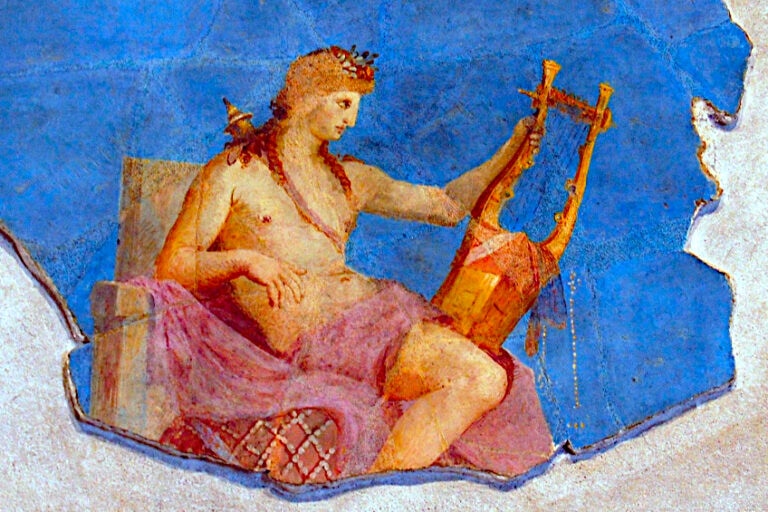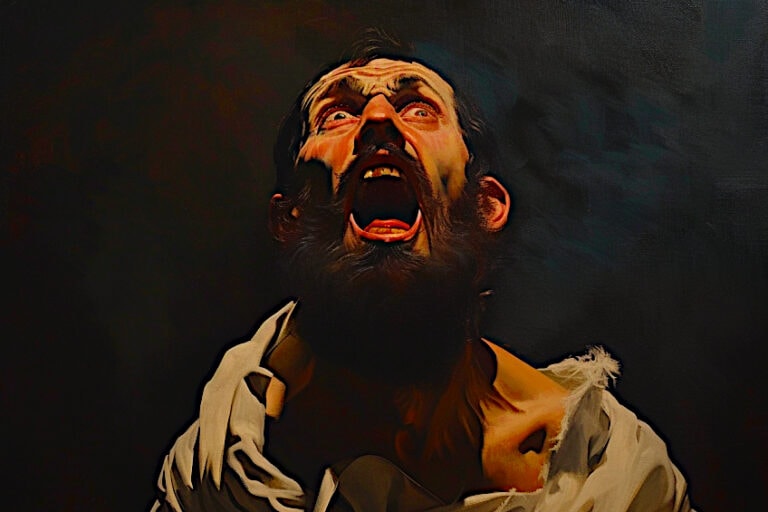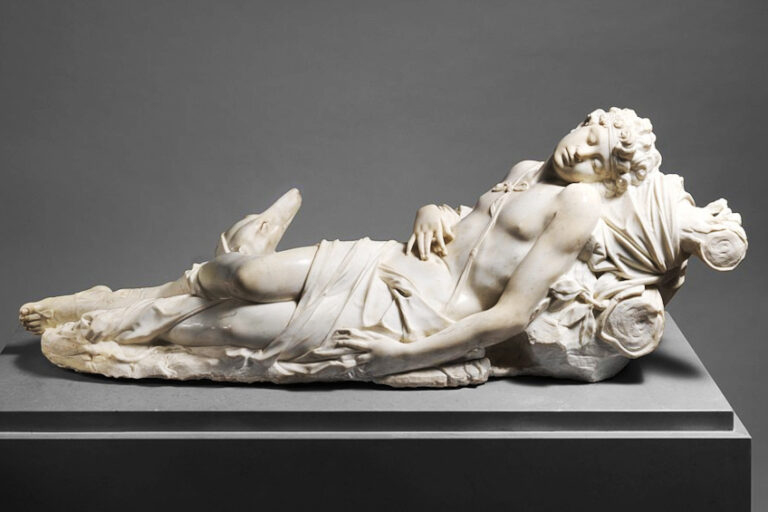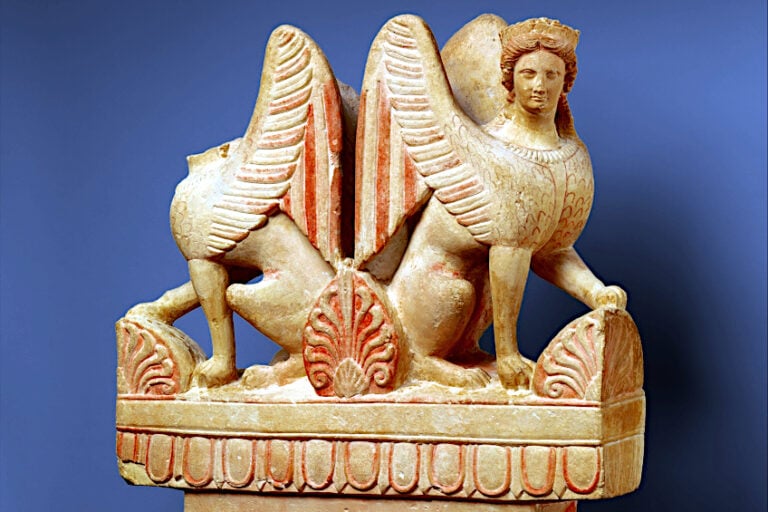Greek God Hermes – The Helpful Guide at the Boundary
What is Hermes the god of in the Greek pantheon of Olympic deities? The Greek god Hermes is considered to be the god of boundaries and the messenger of the Olympian gods. As Psychompompus he escorted the souls of the dead to the banks of the Styx. Hermes was also the protector of merchants, thieves, human messengers, and other travelers, and therefore Hermes’ symbol was his winged sandals. Below, we shall be delving into Hermes’ mythology, discovering Hermes’ Roman name, Hermes’ characteristics, and addressing your questions on the Greek god Hermes, such as, “what does Hermes look like?’.
What Is Hermes the God Of?
| Name | Hermes |
| Gender | Male |
| Personality | Cunning, deceptive, inventive, helpful |
| Parents | Zeus and Maia |
| Spouse | Aphrodite (lover) |
| Siblings | Apollo, Artemis, Athena, Hephaestus, Ares, Enyo, Eris, Ersa, Hebe and the heroes fathered by Zeus |
| Domain | Boundaries, messengers, animal herding, trade, athletics, and travel |
| Symbols | Winged sandals and helmet, tortoise, rooster, caduceus, and satchel |
So, we know that he eventually became the god of thieves, travelers and messengers, but what was Hermes the god of initially? The Greek god Hermes started as a Chthonic god and was associated with the underworld. He was able to traverse the world freely using his winged sandals.
Part of his role was to guide the souls of the dead to the banks of the River Styx where they would board Charon’s ferry to cross over to the Underworld. Over time, his role expanded to include any sort of traveling, roads, boundaries, and trade.
One of his most important symbols is the staff with wings and two snakes intertwined around it, known as a caduceus. Another object closely associated with Hermes was the type of statue known as a “Herm”. These column-like sculptures were erected at boundaries and featured the head of typically bearded Hermes with an erect phallus. Hermes was identified with the major Roman god Mercury, who oversaw of trade, boundaries, and trickery. Double headed sculptures connected to the cult of Hermes which were found in Greece also suggest a god dating from later antiquity comprised of a fusion of Hermes and Janus, the Roman god of doorways, and endings and beginnings.
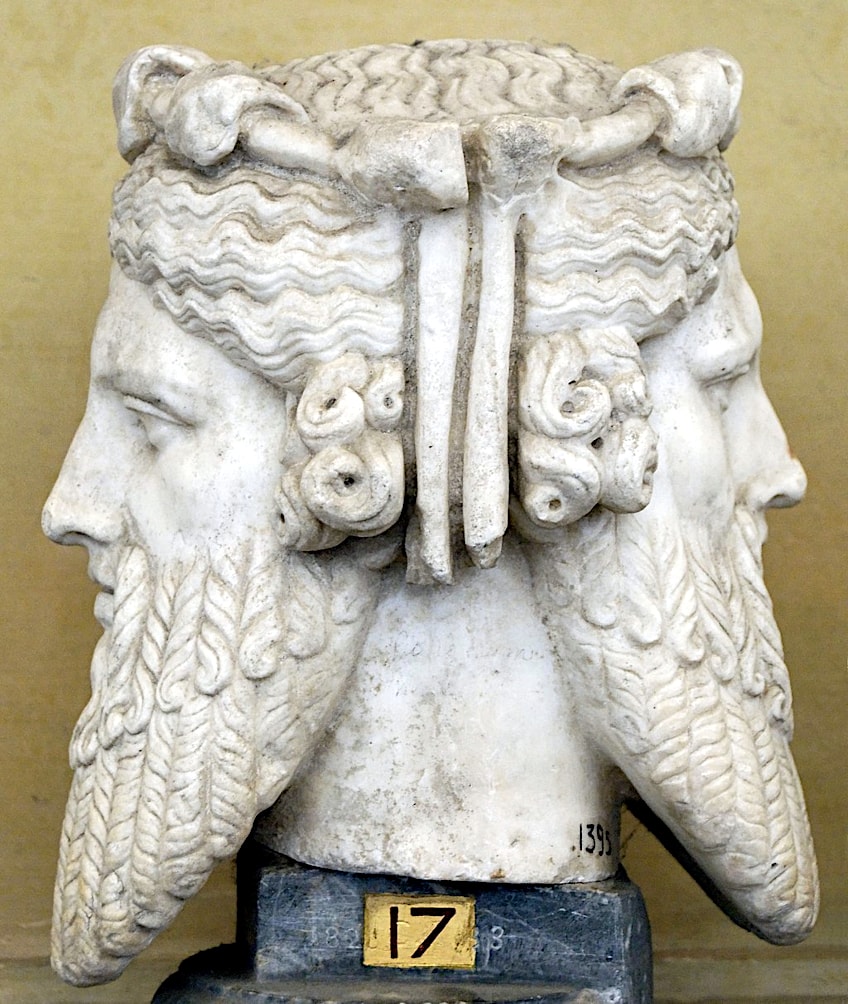 Roman double-herm copied from a Greek original combining the imagery of Janus with that of Hermes; Vatican Museums, CC BY 3.0, via Wikimedia Commons
Roman double-herm copied from a Greek original combining the imagery of Janus with that of Hermes; Vatican Museums, CC BY 3.0, via Wikimedia Commons
Background and Family
While the etymology of Hermes is unclear, and probably not proto-Indo-European, a reference to a Mycenean divinity identified as *hermāhās in linear B texts (15th-13th Centuryies BCE), suggests that this is a god of great antiquity. In Greek mythology Hermes is the son of Zeus and Maia, daughter of the Titan Atlas. Maia was said to have given birth to Hermes in a remote cave atop Mount Cyllene in Arcadia, Greece, as recounted by Hesiod, the ancient Greek poet.
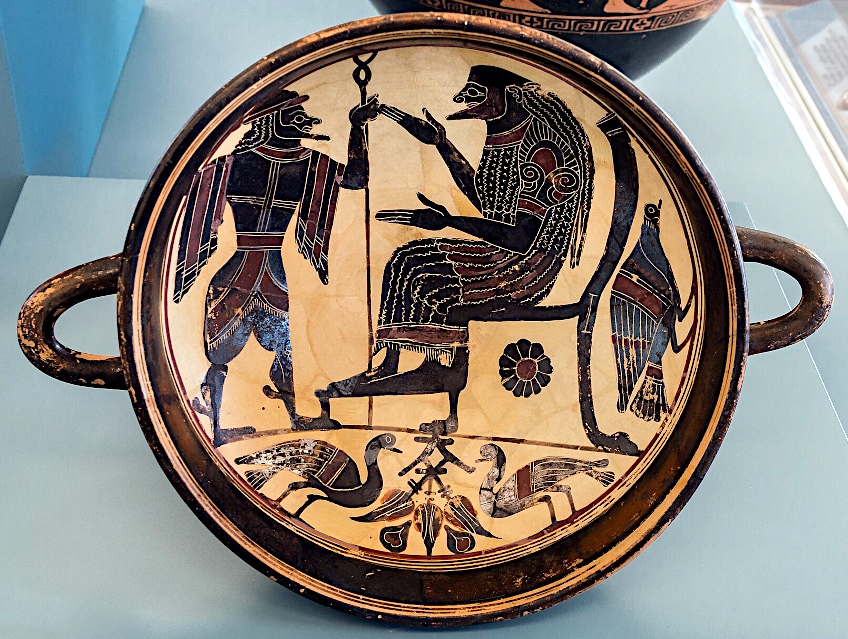 Laconian black-figure kylix with a depiction of Hermes standing before Zeus (c. 550-530 BCE); ArchaiOptix, CC BY-SA 4.0, via Wikimedia Commons
Laconian black-figure kylix with a depiction of Hermes standing before Zeus (c. 550-530 BCE); ArchaiOptix, CC BY-SA 4.0, via Wikimedia Commons
Hermes possessed extraordinary powers even in infancy. He demonstrated his cunning and mischievous behavior within mere hours of his birth. He managed to escape from his cradle and went on a few renowned adventures. One of his most memorable exploits was the theft of his half-brother Apollo’s livestock while skillfully concealing his tracks to evade being detected.
As a result, the Greek god Hermes grew to be associated with thieves, and he succeeded in keeping the stolen herd until the satyrs discovered it in an Arcadian cave.
After an appearance before the Olympian gods, Hermes was granted permission to keep the herd in exchange for giving Apollo his lyre. This story depicts the god’s relationship with moral and physical boundaries, as well as his crossing of them.
Hermes’ Role
Hermes appears in several mythical stories as a messenger of the gods of Olympus, mainly for Zeus. Probably his most famous act was his slaughter of the many-eyed monster Argos on Zeus’ command in order to liberate Io. Hermes additionally freed Ares from the twin Giants Ephialtes and Otus, who had confined the god of war for a year in a cauldron. One of Hermes’ most important roles was as a soul guide to the banks of the river Styx from where the boatman Charon would convey them to Hades. Hermes was typically regarded as a trickster, having stolen Apollo’s cattle, Artemis’ arrows, Poseidon’s trident, and Aphrodite’s girdle at different points in time.
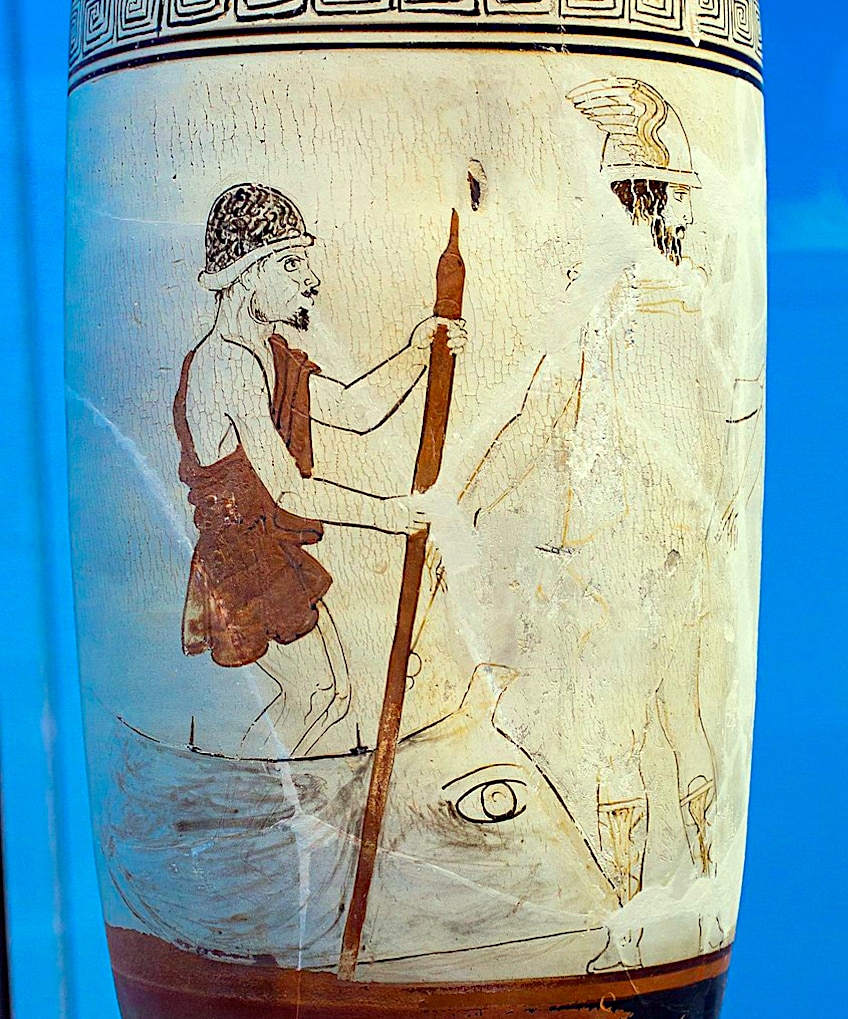 White-ground lekythos with a depiction of Charon in his boat receiving Hermes and the soul of a woman (c. 430 BCE); ArchaiOptix, CC BY-SA 4.0, via Wikimedia Commons
White-ground lekythos with a depiction of Charon in his boat receiving Hermes and the soul of a woman (c. 430 BCE); ArchaiOptix, CC BY-SA 4.0, via Wikimedia Commons
Hermes appears in Homer’s Iliad and Odyssey. Although he is sent to advise the Trojan King Priam in his effort to rescue the body of his slain son Hector in one section, he is amongst the Olympians who supports the Achaeans. Homer’s most common description of the Greek god Hermes is “the guide”. Hermes was of great assistance to Odysseus, particularly on his long return journey to Ithaca, for instance, by providing a remedy to Circe’s charms. Perseus was another hero who received assistance from Hermes, who gave him an indestructible blade of adamantine and guided him to the three Graeae who would reveal the whereabouts of Medusa.
Hermes has been associated with the invention of the alphabet, fire, dice – and hence was venerated by gamblers as a patron of luck and prosperity – and musical instruments, particularly the lyre, which he crafted from tortoiseshell.
Because of his creation of the pan pipes, Hermes was known as the deity that ruled over shepherds and thieves. He was the patron saint of travelers, as herms were placed at boundaries to ensure Hermes would protect those who crossed them. Furthermore, Hermes also served as protector at the entryways of homes and people regularly erected little marble stelai in his honor in front of their doorways.
 Campanian red-figure kylix with a depiction of a sanctuary of Hermes with a ram at the altar (450 BCE); Zde, CC BY-SA 4.0, via Wikimedia Commons
Campanian red-figure kylix with a depiction of a sanctuary of Hermes with a ram at the altar (450 BCE); Zde, CC BY-SA 4.0, via Wikimedia Commons
Hermes was also renowned for his diplomatic abilities, known as the patron of languages and eloquence. Interpreters (yet another kind of boundary-crossers) considered the deity who conveyed words from sender to recipient as their patron, and the research and deciphering of texts bear his name even to this day: hermeneutics. Hermes also had an association with gymnasia and was viewed as the guardian of youths throughout the Hellenistic era. Hermes’ Roman name, Mercury, is the name of the planet that orbits the sun the fastest, reflecting the god’s own swift journeys through the different realms.
Hermes’ Characteristics and Personality
Next up, we will explore Hermes’ characteristics and Hermes’ symbols. We know that he was regarded as a fast messenger of the gods, but what is he like as a person and what does Hermes look like? Let’s begin with the Greek god Hermes’ personality.
The Personality of Hermes
In ancient Greek myth and literature Hermes was described as a mischievous and crafty trickster. As the Olympians’ herald, he was eloquence and persuasive, sent by Zeus to settle disputes and provide guidance and advice. Hermes is also typically associated with agility and speed, but his quick reaction time extends beyond physical movement to his cerebral skills, allowing him to process information and respond quickly.
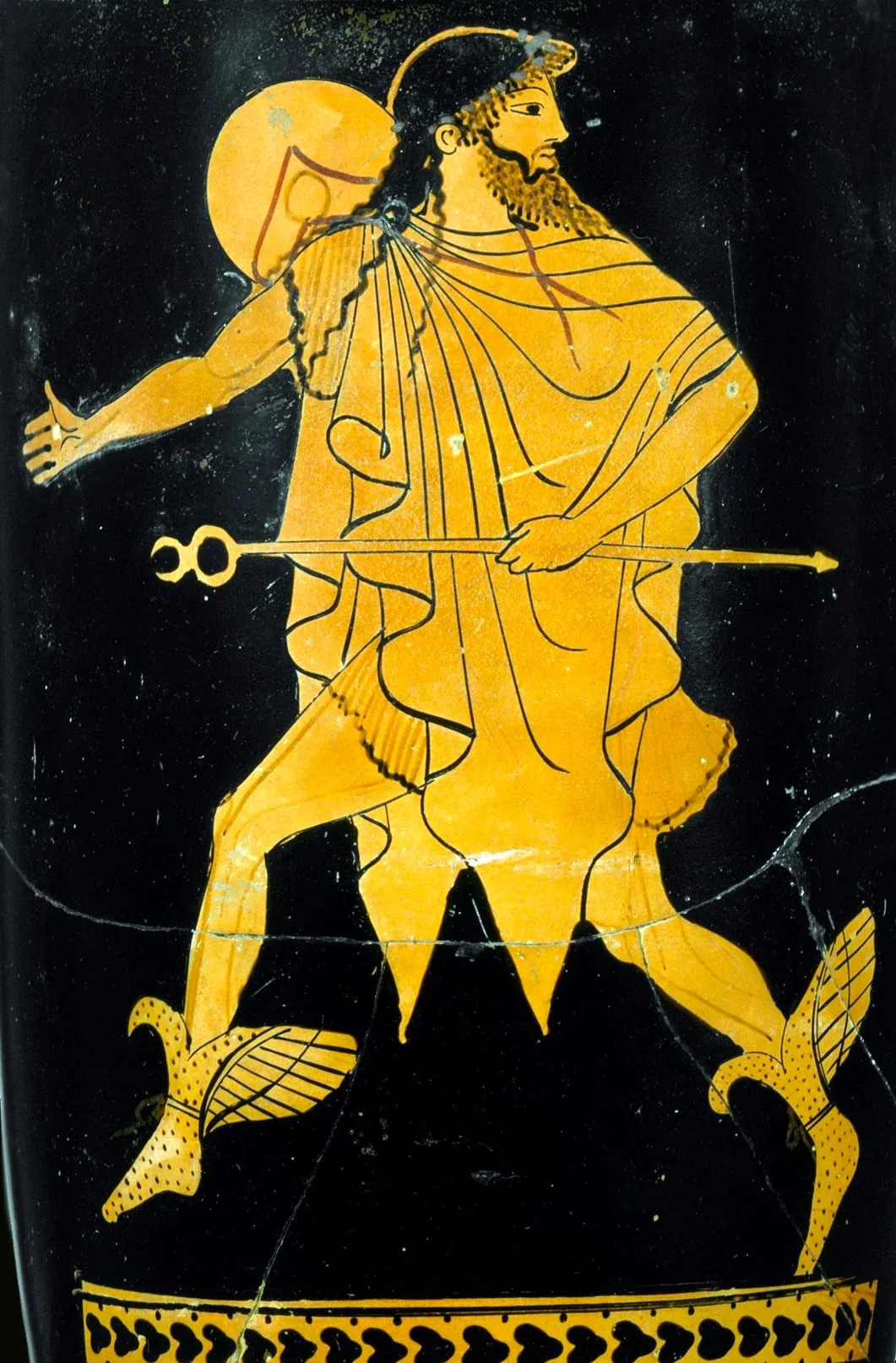 Attic red-figure lekythos with a depiction of Hermes (c. 480-470 BCE); Tithonos Painter, CC0, via Wikimedia Commons
Attic red-figure lekythos with a depiction of Hermes (c. 480-470 BCE); Tithonos Painter, CC0, via Wikimedia Commons
The Physical Appearance of the Greek God Hermes
Hermes’ image developed and evolved alongside Greek art and society. He was often portrayed as a mature man sporting a beard and dressed like a messenger, traveler, or shepherd in Archaic Greece. This representation endured on the Hermai stone pillars, which acted as boundary marks, highway markings, cemetery markers, and votive gifts.
During the Classical and Hellenistic periods, representations of Hermes changed from the tradition of a bearded traveler to include depictions of the god in line with the handsome youthful Hermes encountered by Odysseus in the Odyssey.
Phidias produced a statue of a renowned Hermes Logios, while Praxiteles produced another, equally well-known, of the Greek god Hermes holding the infant Dionysus.
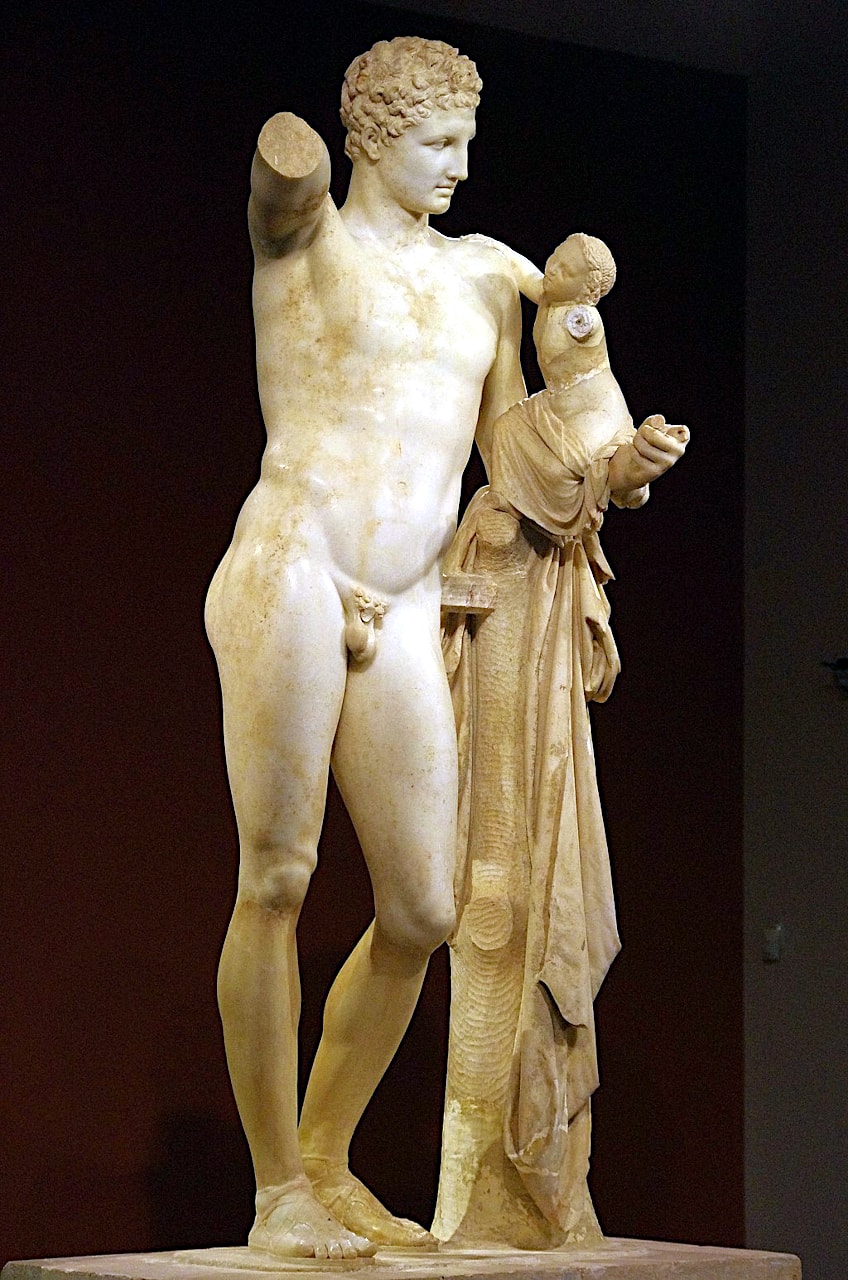 Statue of Hermes with the infant Dionysus attributed to Praxiteles (4th Century BCE); Paolo Villa, CC BY-SA 4.0, via Wikimedia Commons
Statue of Hermes with the infant Dionysus attributed to Praxiteles (4th Century BCE); Paolo Villa, CC BY-SA 4.0, via Wikimedia Commons
Attributes and Symbols
Throughout the Hellenistic, Roman, and Western eras, however, many of his distinguishing objects are present as proof of his identity, but not usually all at once. Among these items is the petasos, a wide-brimmed hat that was commonly worn by travelers and was subsequently decorated with a pair of little wings; sometimes this hat is missing and may have been substituted with wings emerging straight from the hair. The caduceus, a staff with two interwoven snakes that are sometimes capped with a sphere and a pair of wings, is another popular Hermes symbol.
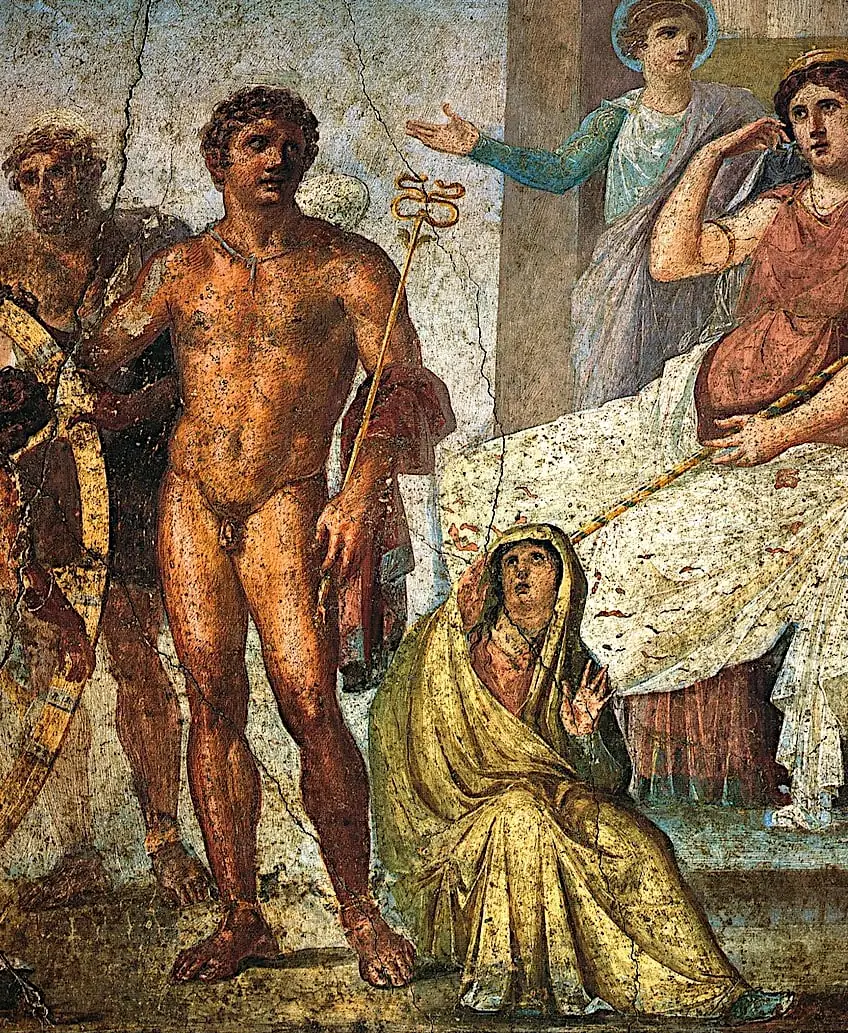 Fresco from Pompeii showing Hermes holding the caduceus (60-79 CE); WolfgangRieger, Public domain, via Wikimedia Commons
Fresco from Pompeii showing Hermes holding the caduceus (60-79 CE); WolfgangRieger, Public domain, via Wikimedia Commons
Hermes was routinely depicted holding a staff entwined by two snakes, known as the caduceus. A similar type of staff appears as a Babylonian emblem around 3500 BCE. the antiquity of the emblem has even led some scholars to trace the origins of Hermes to a proto-Greek snake god. Other gods were also portrayed in Greece bearing a caduceus, although it was mostly identified with the Greek god Hermes. It was believed to have the ability to make people wake up or go to sleep and is an observable representation of Hermes’ power when being used as a scepter.
The Greek god of Healing Ascelpius is also commonly depicted with a staff around which a single snake is coiled. The Rod of Asclepius is often confused with the caduceus, even though they differ in origin. Yet both these symbols have become emblematic of the modern medical profession.
Hermes’ sandals comprised myrtle and palm branches yet were characterized as “golden, beautiful, and immortal”, able to travel at the speed of the wind. Originally, they did not have wings, but they are represented later in artistic renderings. Wings appear to sprout immediately from the ankles in other illustrations. Hermes has also been represented holding a satchel while wearing a cloak that granted invisibility. Hermes’ weapon was a golden sword, which he used to slay Argos and which he also loaned to Perseus to use against Medusa.
Domain of Influence
Hermes was recognized as a Chthonic deity who was closely associated with the earth and underworld from the earliest accounts of his worship.
As a Chthonic deity, Hermes’ adoration also featured a fertility aspect, with the phallus representing one of his popular symbols.
The incorporation of phallic iconography linked with the Greek god Hermes and placed, in the shape of stone pillars, at the household entryways could suggest an ancient belief that he was used as a symbol of the fertility of the household, especially the head of the household’s potency and ability to reproduce.
The God of Boundaries
Hermes was the god tasked with protecting boundaries in Ancient Greece. Piles of stones erected to mark boundaries were known as herma, travelers would often contributed a stone to the mound along with a prayer for protection. Plato credited Hipparchus with the invention of this type of depiction of the god Hermes. However, these semi-abstract representations of gods long predate the Greeks and instead derived from aniconic imagery. In antiquity, objects such as unusually shaped or colored stones, or rudimentary carved wooden statues that were claimed to have fallen from the skies enjoyed far greater veneration that beautifully carved naturalistic depictions of the gods.
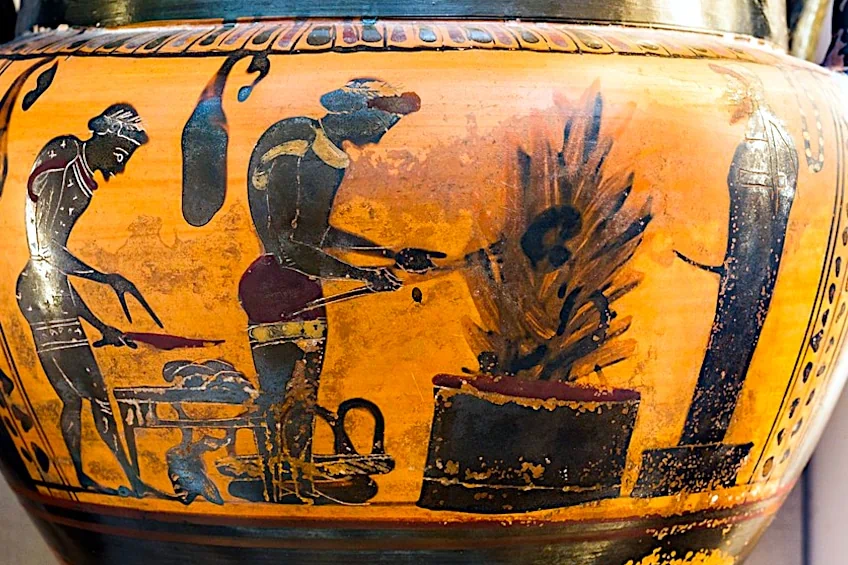 Attic black-figure column-krater with a depiction of two youths burning sacrificial meat on an altar of Hermes located in front of a herm (c. 520-510 BCE); ArchaiOptix, CC BY-SA 4.0, via Wikimedia Commons
Attic black-figure column-krater with a depiction of two youths burning sacrificial meat on an altar of Hermes located in front of a herm (c. 520-510 BCE); ArchaiOptix, CC BY-SA 4.0, via Wikimedia Commons
These boundary markers also took the form of pillars carved from wood or stone. The more elaborate varieties featured the head of the god and an erect phallus, while rudimentary versions only resembled phalluses. During the Peloponnesian War in 415 BCE, the Athenian fleet was preparing to set sail for Syracuse when all of the Athenian Herms were vandalized. This represented an act of great sacrilege. At the time, the Athenians suspected it was a group of saboteurs, originating from either Syracuse or from the anti-war movement within Athens itself.
Alcibiades, Socrates’ pupil, was accused of participation, and one of the allegations subsequently leveled against Socrates that led to his death 16 years later was the claim that he had somehow corrupted Alcibiades or neglected to steer him away from his ethical corruption.
The God of Shepherds
The Greek god Hermes was also the patron of herds, flocks, and shepherds, which may be related to his early origins as an aspect of Pan. Hermes was honored in Boeotia for saving the village from a plague by dragging a ram around the walls of the city. This incident was celebrated with an annual celebration in which a lamb was carried around the city by “the most beautiful youth” and then slaughtered to cleanse and protect the town from sickness, drought, and hunger.
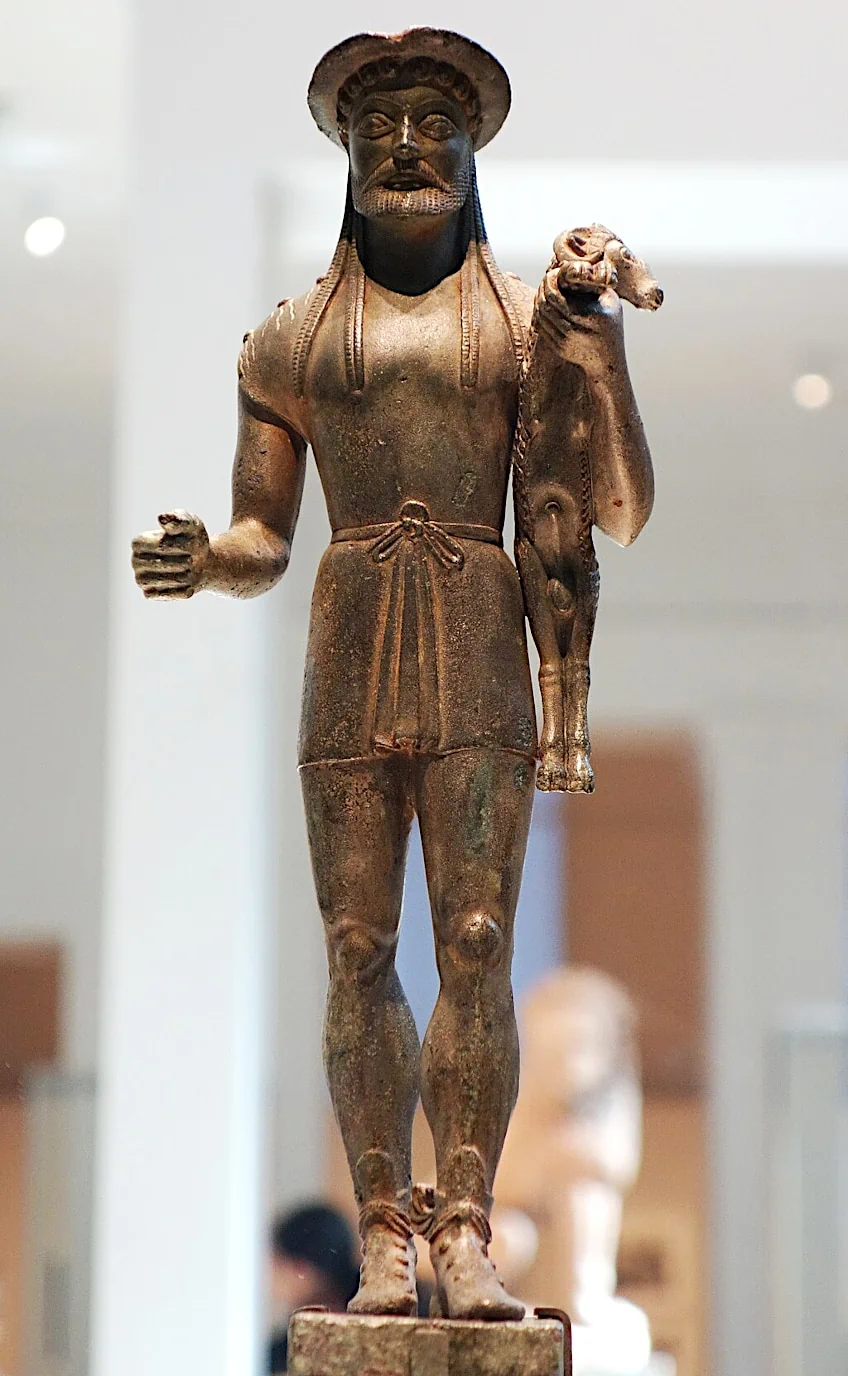 Archaic period statuette of Hermes Kriophoros (ram-bearer) (late 6th Century BCE); Mark Landon / Wikimedia Commons
Archaic period statuette of Hermes Kriophoros (ram-bearer) (late 6th Century BCE); Mark Landon / Wikimedia Commons
Several representations of the god as a shepherd carrying a ram or a lamb have been discovered throughout the Mediterranean world, which suggests that Hermes’ characteristics as “The Good Shepherd” potentially influenced early Christianity, especially Christ’s description in the Gospel of John.
Patron of Athletes
Hermes was revered as the patron god of athletics and was invoked by individuals competing in sporting events. Before their competitions, ancient Greek athletes would pray to Hermes while offering sacrifices in order to gain his blessing and assistance. Hermes fostered and rewarded athletic abilities. He was said to encourage sportsmen by bestowing power, agility, and stamina in their chosen sports
The great hero Heracles, is said to have founded the Olympic Games in honor of Zeus, while Hermes is believed to have presided over the contests, assuring fair play as well as good sportsmanship among the competitors.
Hermes was heavily associated with foot racing, particularly sprinting. He was renowned as the fastest of all the Olympian gods, and runners regularly invoked his speed. Hermes’ Sandals became a symbol of the speed and agility sought by sportsmen. These metaphorical characteristics expressed the desire to be as fast as Hermes in sports events.
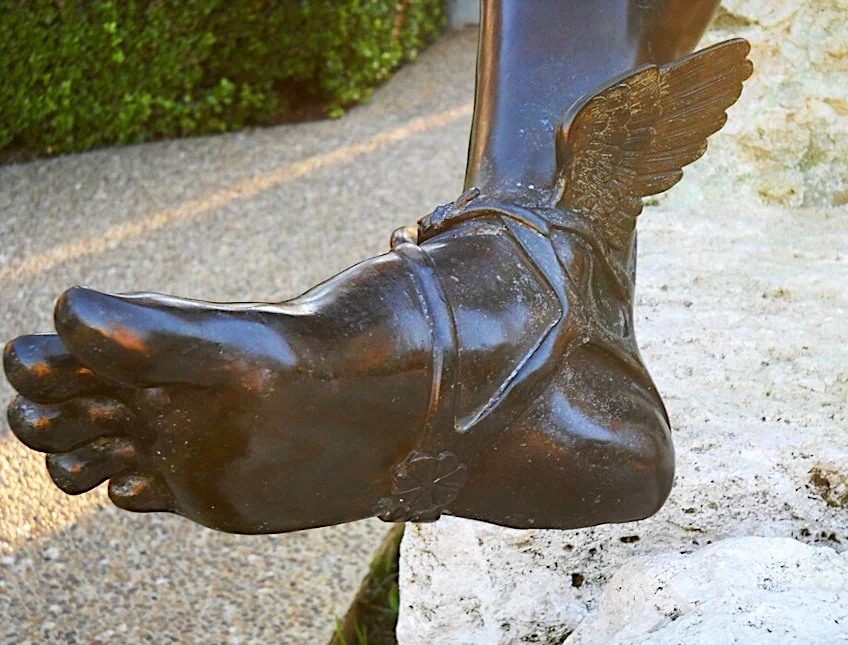 Detail of the Seated Hermes showing the god’s winged sandal (1st Century CE Roman copy of a Greek original from the late 4th or early 3rd Century BCE); Dave & Margie Hill / Kleerup, CC BY-SA 2.0, via Wikimedia Commons
Detail of the Seated Hermes showing the god’s winged sandal (1st Century CE Roman copy of a Greek original from the late 4th or early 3rd Century BCE); Dave & Margie Hill / Kleerup, CC BY-SA 2.0, via Wikimedia Commons
The Greek God Hermes’ Mythology
Hermes is also one of the few Olympians with access to the Underworld, serving as a guide for the dead souls as they entered the afterlife. Hermes is featured in many fascinating Greek myths and legends. Let’s explore some of the well-known myths involving the Greek god Hermes.
Hermes and the Lyre
Hermes, the son of Zeus and Maia, was not an average child and quickly rose to prominence among the Gods. Hermes climbed out of his crib while his mother was still sleeping, while still a newborn. As Hermes exited the cave, he noticed a tortoise. He grabbed the animal, flipped it over and gathered the marrow from her shell. Hermes then trimmed reed stalks to size, inserted them inside the shell, and secured their ends over the back. He then completed the world’s first lyre, by reinforcing its framework with cowhide, attaching a yoke, and stretching across seven sheep-gut strings. Hermes then composed his first song, a hymn in honor of his own birth.
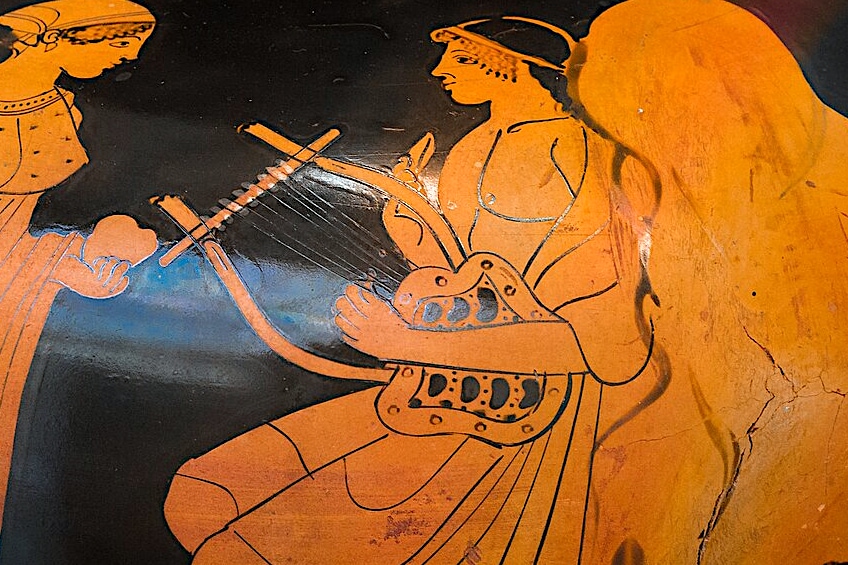 Detail of an Attic red-figure hydra showing a tortoise-shell lyre (c. 470 BCE); ArchaiOptix, CC BY-SA 4.0, via Wikimedia Commons
Detail of an Attic red-figure hydra showing a tortoise-shell lyre (c. 470 BCE); ArchaiOptix, CC BY-SA 4.0, via Wikimedia Commons
Stealing Cattle from Apollo
Hermes was ravenous after growing up so quickly on the day of his birth and creating the Lyre in a matter of hours. In pursuit of sustenance and mischief, the ‘divine trickster’ traveled to Thessaly, where he stumbled across Apollo’s herd of cattle. Hermes swiftly took 50 of Apollo’s calves. To conceal his footprints, he designed a pair of wicker sandals, and he had the cattle walk backward in order to confuse anybody who followed them. Hermes slaughtered two of the animals, skinned them, sacrificed them, and concealed the remainder of the herd. Satisfied, he returned to his cradle, where Maia found out about his misbehavior and scolded him for stealing from his half-brother.
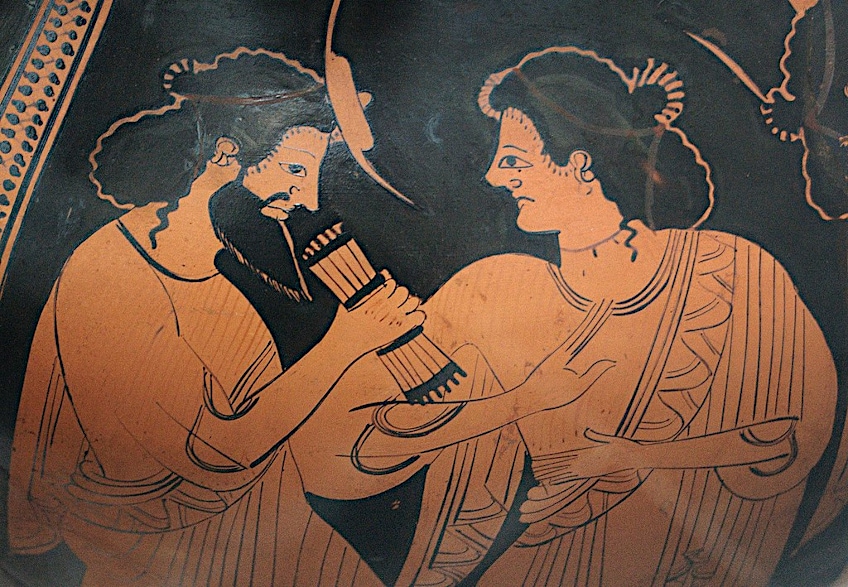 Detail of an Attic ref-figure belly-amphora showing Hermes and his mother Maia attending a council of the gods (c. 500 BCE); Carole Raddato from FRANKFURT, Germany, CC BY-SA 2.0, via Wikimedia Commons
Detail of an Attic ref-figure belly-amphora showing Hermes and his mother Maia attending a council of the gods (c. 500 BCE); Carole Raddato from FRANKFURT, Germany, CC BY-SA 2.0, via Wikimedia Commons
Apollo soon arrived in search of his missing herd and confronted Maia and Hermes, and the subject was eventually brought before Zeus on Mount Olympus. Standing in front of the god of order and law, Apollo related how he succeeded in tracking down the thief. Hermes defended himself using convoluted lies and ridiculous oaths. Zeus, who was able to see straight through the youth’s tales, was pleased by the cunning child and felt sympathy for his naughty progeny.
Zeus laughed and promised Hermes a position among the powerful gods of Olympus on the condition that he first return Apollo’s stolen livestock. Hermes complied, bringing back the remaining herd and offering Apollo his newly created lyre in exchange for the two cows he had already sacrificed.
Hermes and Hera
Hermes was credited with the origins of the Milky Way. Hera, the queen of the Olympians and Zeus’ wife, was outraged at her husband’s constant affairs with other women. While she was notorious for making life tough for Zeus’ lovers and their progeny, she held particular hatred for the hero Herakles.
Hermes tricked Hera into breastfeeding the infant Herakles, so that the breastmilk of the queen of the gods would make him the strongest man alive. When Hera awoke she pushed the baby away, and her milk spewed across the heavens.
Hermes and Argus
In Greek mythology, Argus Panoptes was a hundred-eyed giant who served Hera, Queen of Olympus. His most important responsibility was to protect the white cow from the King of the gods, Zeus. Io was a human Argive princess who served as one of the Goddess Hera’s priestesses at Argos. Zeus, who eventually fell in love with her, came across her and pursued her. When Hera learned of the romance and attempted to apprehend the lovers, Zeus changed Io into a white cow.
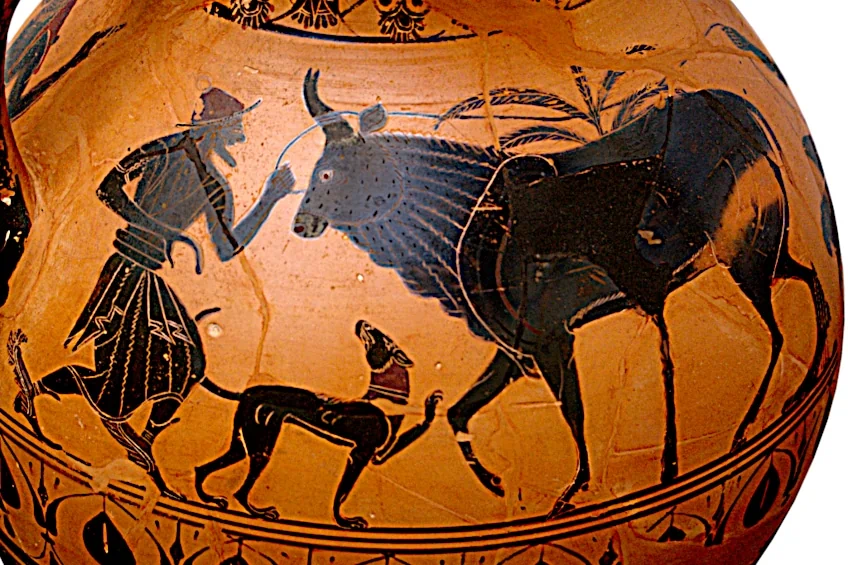 Black-figure amphora with a depiction of Hermes and Io disguised as a cow (540-530 BCE); See page for author, CC0, via Wikimedia Commons
Black-figure amphora with a depiction of Hermes and Io disguised as a cow (540-530 BCE); See page for author, CC0, via Wikimedia Commons
Hera, though, was not duped and insisted that Zeus give her the cow as a gift. Hera then tethered the cow to an Olive tree and assigned Argus to keep Io safe from Zeus. Argus had a hundred eyes covering his entire body, yet he only closed 50 of them at any given time. Zeus, who was discouraged, sought counsel from Hermes.
Hermes came to Zeus’ aid and dressed himself as a shepherd. He then put the formidable monster to sleep with his music before killing him. Zeus was able to release the white cow Io at that point.
Hermes and Aphrodite
Hermes was one of Aphrodite’s many suitors, but when the goddess of love rebuffed his approaches, Hermes felt extremely upset and dejected. Zeus felt sorry for the fun and mischievous Hermes’ plight and decided to assist him.
When Aphrodite was taking a dip in the Achelous River, Zeus summoned an eagle to remove her sandal and deliver it to Amythaonia of Egypt, who then handed it to Hermes.
When Aphrodite eventually came to her in search of her sandal, Hermes managed to seduce her in exchange for the sandal. The eagle was subsequently honored by being placed in the sky as the constellation Aqtilla.
 Venus and Mercury Blindfold Cupid by Bartholomeus Spranger (1597); Bartholomeus Spranger, Public domain, via Wikimedia Commons
Venus and Mercury Blindfold Cupid by Bartholomeus Spranger (1597); Bartholomeus Spranger, Public domain, via Wikimedia Commons
Hermes and Aphrodite had a son named Hermaphroditus after his parents. He was an exceptionally handsome youth and the nymph Salmacis became obsessed with him. HOwever, he rejected her advances. When he went to bathe in a pool she ambushed him, wrapped her arms around him and prayed to the gods that they should be united forever. The gods complied and Salmacis and Hermaphroditus became one being comprised of both sexes.
Hermes and Ares
Poseidon and Iphimedia, Aloeus’ wife, had two sons, Ephialtes and Otus. The twin brothers were mighty but arrogant giants, who always caused problems for the Gods. Once the two plotted to abduct Ares and succeeded, or, according to another tale, kidnapped him as he tried to prevent them from reaching Mount Olympus.
Ares was imprisoned in a cauldron for a year, and it was the cunning Greek god Hermes who uncovered his whereabouts and eventually liberated him.
Ares and Hermes were embroiled in a boxing contest in another myth about a Naiad nymph. Tanagra was Asopus’ daughter, the river God, and Metope. Tanagra was the Nymph of the Fountain, and her lovers included Ares and Hermes. To choose her companion, the Gods agreed upon a boxing match. Hermes won the fight and slept with Tanagra. Her name was given to the Baeotian village where Hermes abducted her.
Hermes and the Heroes
Odysseus benefited substantially from his two encounters with Hermes during his ten-year trip following the Trojan War. When the enchantress Circe fell in love with Odysseus and set a trap for him for the first time, Hermes offered him a rare plant that shielded him from Circe’s charms.
When Odysseus was compelled to dwell with the nymph Calypso for seven years, Hermes appeared with Zeus’ message, telling Calypso to let Odysseus go home.
When the Greek hero Perseus was on his way in search of Medusa, Hermes appeared and advised him that the mission he was doing was very risky but not impossible. Hermes not only led Perseus to the Gorgons’ lair, but also offered him items to aid in his mission, such as the golden blade that could sever Medusa’s neck, a leather pouch to carry her head in, and a set of winged sandals that allowed Perseus to fly.
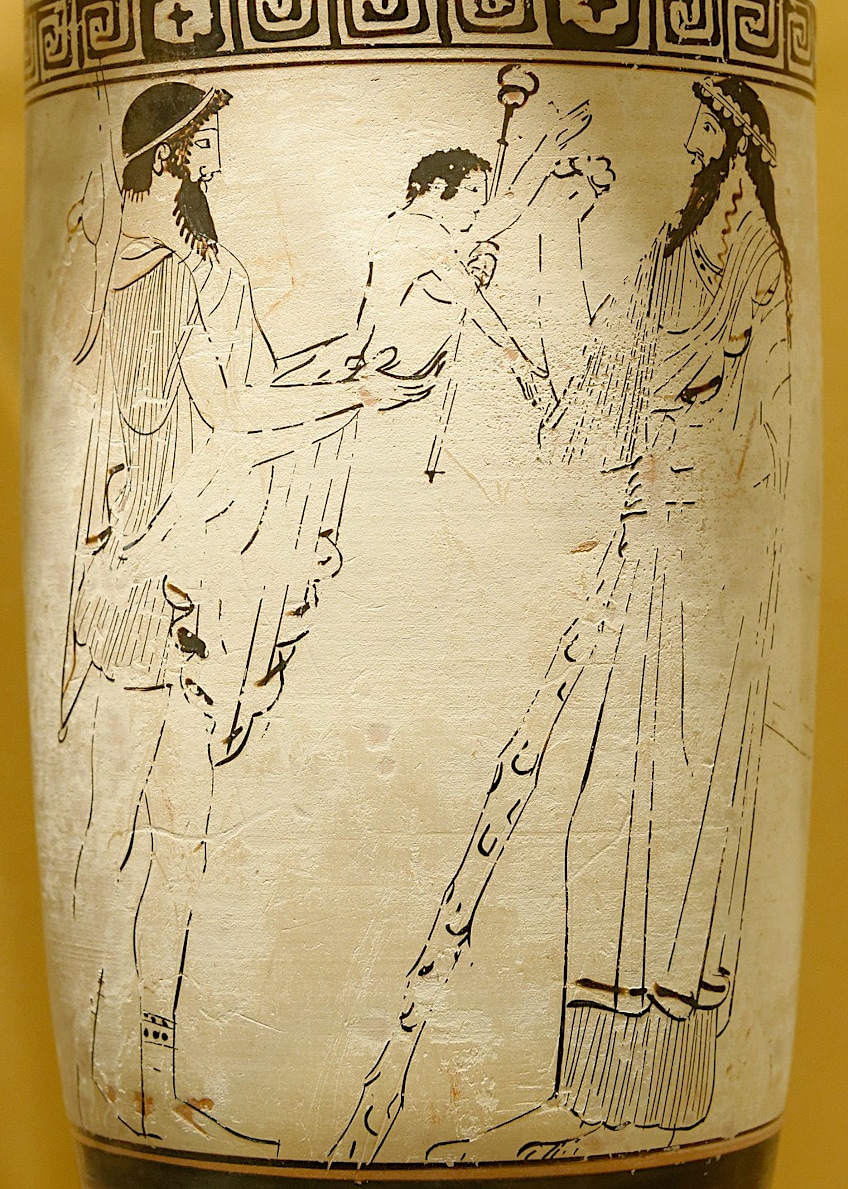 Attic white-ground red-figure lekythos with a depiction of Hermes handing the young hero Achilles to his tutor Chiron (between 450 and 400 BCE); National Museum of Denmark, Public domain, via Wikimedia Commons
Attic white-ground red-figure lekythos with a depiction of Hermes handing the young hero Achilles to his tutor Chiron (between 450 and 400 BCE); National Museum of Denmark, Public domain, via Wikimedia Commons
During Heracles’ 12th and last labor, he was assigned the difficult task of recovering the three-headed hound Cerberus from the Underworld and returning him to King Eurystheus. Athena and Hermes both assisted him in completing this task by leading the Hero to the Styx River, from where he journeyed to the Underworld in Charon’s boat.
Hermes in Jungian Psychology
The Greek god Hermes is associated with the Trickster archetype, which is a prevalent figure in mythology and folklore across the world. The Trickster personifies human nature’s disruptive, transformational, and unexpected attributes. Hermes reflects the Trickster archetype’s attributes of deceit, humor, and the capacity to defy traditions with his mischievous and cunning nature.
Hermes symbolizes the role of communication and connection in Jungian psychology as a messenger of the gods and a mediator between the various realms.
He represents the ability to bridge gaps, whether between the conscious and unconscious mind, between individuals and groups, or between different elements of oneself. Hermes’ communicative function represents the psychological desire for good communication, discourse, and integration. In the framework of Jungian psychology, Hermes’ position as a psychopompus, escorting souls to the Underworld, may be interpreted as the promotion of psychological transition and growth.
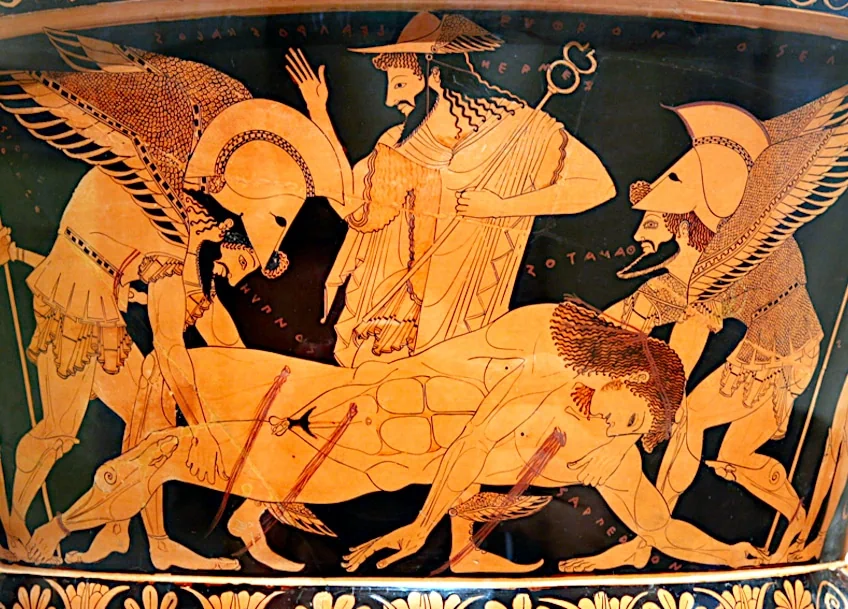 Attic red-figure calyx-krater signed by Euxitheos and Euphronios depicting Hermes Psychopompus accompanying Hypnos and Thanatos as they take Sarpedon’s body home (c. 515 BCE); Jaime Ardiles-Arce (photographer). Krater by Euphronios (painter) and Euxitheos (potter)., Public domain, via Wikimedia Commons
Attic red-figure calyx-krater signed by Euxitheos and Euphronios depicting Hermes Psychopompus accompanying Hypnos and Thanatos as they take Sarpedon’s body home (c. 515 BCE); Jaime Ardiles-Arce (photographer). Krater by Euphronios (painter) and Euxitheos (potter)., Public domain, via Wikimedia Commons
Hermes signifies the trip into the unconscious, supporting individuals in confronting their shadows, reconciling repressed elements of themselves, and facing psychological metamorphosis. Hermes’ diverse personality and ability to navigate multiple domains and occupations represent the quest for individuation. He personifies the concept of accepting and integrating many elements of oneself in order to reach psychological wholeness.
That completes our article on the Greek god Hermes and his role as the messenger of the gods. Not only did he carry messages for the gods, but presided over any area of life that required speedy travel or communication. This includes being the patron of travelers, boundaries, borders, as well as athletes. Due to his many roles and functions, we find that the Greek god Hermes is featured in many tales – right from the day of his birth. Even on his first day, he both stole Apollo’s cattle and created the lyre!
Frequently Asked Questions
What Was Hermes the God of in Greek Mythology?
Hermes was the god who guarded boundaries. These included not just geographic transitions, such as from one region to another, but as guardian at temple gates, Hermes oversaw the boundary between secular and sacred places. In the modern imagination Hermes is best known as the gods’ herald since he could travel anywhere with speed and ease. In myth, Hermes is a helpful god, who conveyed not only messages from Olympus, but also intervened in human affairs where the gods required it. As Olympian herald, Hermes was patron of orators and poets, helping those who called on him to express ideas, communicate messages, and stimulate eloquent conversations. He was thought to help and protect travelers on their journeys, assuring safe passage and hospitality. He controlled the exchange of products and fortune as a god of commerce. Traders and merchants sought his blessings in the hopes of receiving profitable business activities. He was regarded as a patron of thieves, symbolizing his own devious and trickster-like personality.
What Does Hermes Look Like?
In myth, Hermes appears in various forms, an attribute reflected in ancient depictions of this Greek God. He could be shown as a bearded man dressed in a traveler’s cloak and petasos (broad-brimmed hat), or the handsome youth on the cusp of manhood as he appeared to Odysseus in the Odyssey. Hermes’ winged sandals, known as talaria, are one of his most distinguishing attributes. These shoes allow him to move quickly and are sometimes represented with wings on the actual ankles. They represent his swiftness and agility. Hermes often appears with a staff known as the caduceus, which is a rod with two serpents coiled around it and wings on top. As the god most at home in in-between spaces, Hermes occasionally appears with androgynous characteristics, blurring the lines between genders.

I am deeply passionate about history and am constantly fascinated by the rich and complex stories of the past. As the editor-in-chief of learning-history.com, I have the opportunity to share this passion with a wide audience through the creation and distribution of engaging and informative content about historical events, persons, and cultures. Whether it’s through writing articles and blog posts or creating videos or podcasts, I strive to bring the past to life in a way that is both accurate and enjoyable. My expertise in history, combined with my strong writing and communication skills, allows me to effectively communicate complex historical concepts and make them accessible and interesting to a wide range of readers. I am truly grateful for the opportunity to share my love of history with others through my work on learning-history.com.


